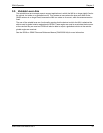
32 SPAN-IGM User Manual Rev 2
Chapter 3 SPAN Operation
3.2.2 Navigation Mode
Once the alignment routine has successfully completed, SPAN enters navigation mode.
SPAN computes the solution by accumulating velocity and rotation increments from the IMU to generate
position, velocity and attitude. SPAN models system errors by using a filter. The GNSS solution, phase
observations and automatic zero velocity updates (ZUPTs) provide updates to the filter. Peripheral
updates can also be supplied; wheel sensor for displacement updates or an external receiver for heading
updates.
Following the alignment, the attitude is coarsely defined, especially in heading. Vehicle dynamics,
specifically turns, stops and starts, allow the system to observe the heading error and allows the heading
accuracy to converge. The amount of dynamics required for filter convergence vary by the alignment
quality and maneuvers performed. The INS Status field changes to INS_SOLUTION_GOOD once
convergence is complete. If the attitude accuracy decreases, the INS Status field changes to
INS_HIGH_VARIANCE. When the accuracy converges again, the INS status continues as
INS_SOLUTION_GOOD.
3.2.3 Data Collection
The INS solution is available in the INS specific logs with either a standard or short header. Other
parameters are available in the logs shown in Table 5, Solution Parameters.
Table 5: Solution Parameters
Note that the position, velocity and attitude are available together in the INSPVA, INSPVAS or INSPVAX
logs.
The inertial solution is available up to the rate of the IMU data. Data can be requested at a specific rate
up to the maximum IMU output rate (125 or 200 Hz) or can be triggered by the mark input trigger at rates
up to 20 Hz.
The GNSS-only solution is still available through the GNSS-only logs such as RTKPOS and PSRPOS.
When running SPAN, rates of non-INS logs should be limited to a maximum rate of 5 Hz. Refer to the
OEM6 Family Firmware Reference Manual (OM-20000129) for more details on these logs. INS-only data
logging and output can be at rates of up to the rate of the IMU data.
Parameter Logs
Position
INSPOS or INSPOSS
INSPVA or INSPVAS
INSPOSX or INSPVAX
a
a. These logs contain variance information and are therefore large logs. Use a
low logging rate (<20 Hz) only.
Velocity
INSVEL or INSVELS
INSSPD or INSSPDS
INSPVA or INSPVAS
INSVELX or INSPVAX
a
Attitude
INSATT or INSATTS
INSPVA or INSPVAS
INSATTX or INSPVAX
a
Solution Uncertainty INSCOV or INSCOVS
Ensure all windows, other than the Console, are closed in NovAtel Connect and then use
the SAVECONFIG command to save settings in NVM. Otherwise, unnecessary data
logging occurs and may overload the system.


















